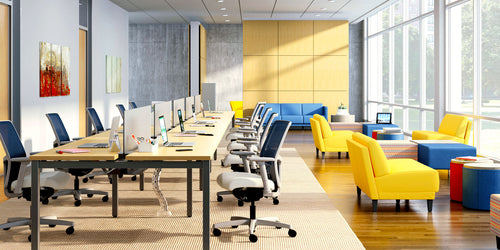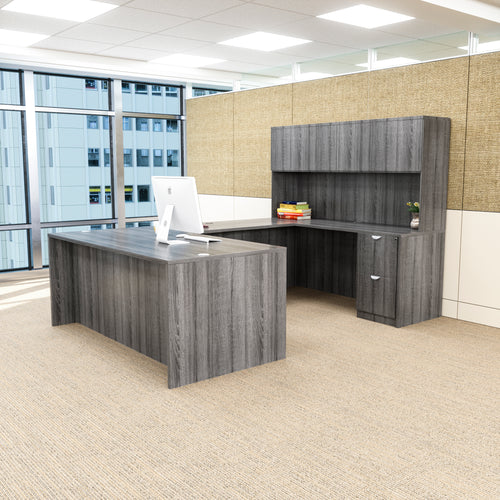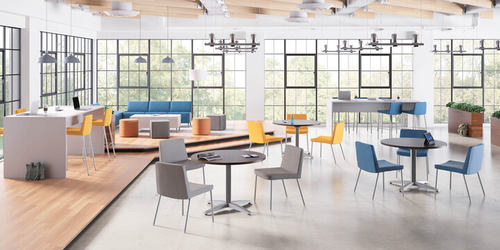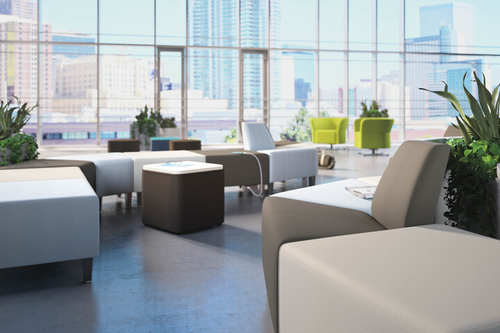-
- Satellite Offices
- Boca Raton
- Miami
- Jacksonville
- Naples
- Sarasota
- Fort Myers
- Gainesville
- Ocala
- Daytona Beach
- Tallahassee
- Hollywood
All Locations
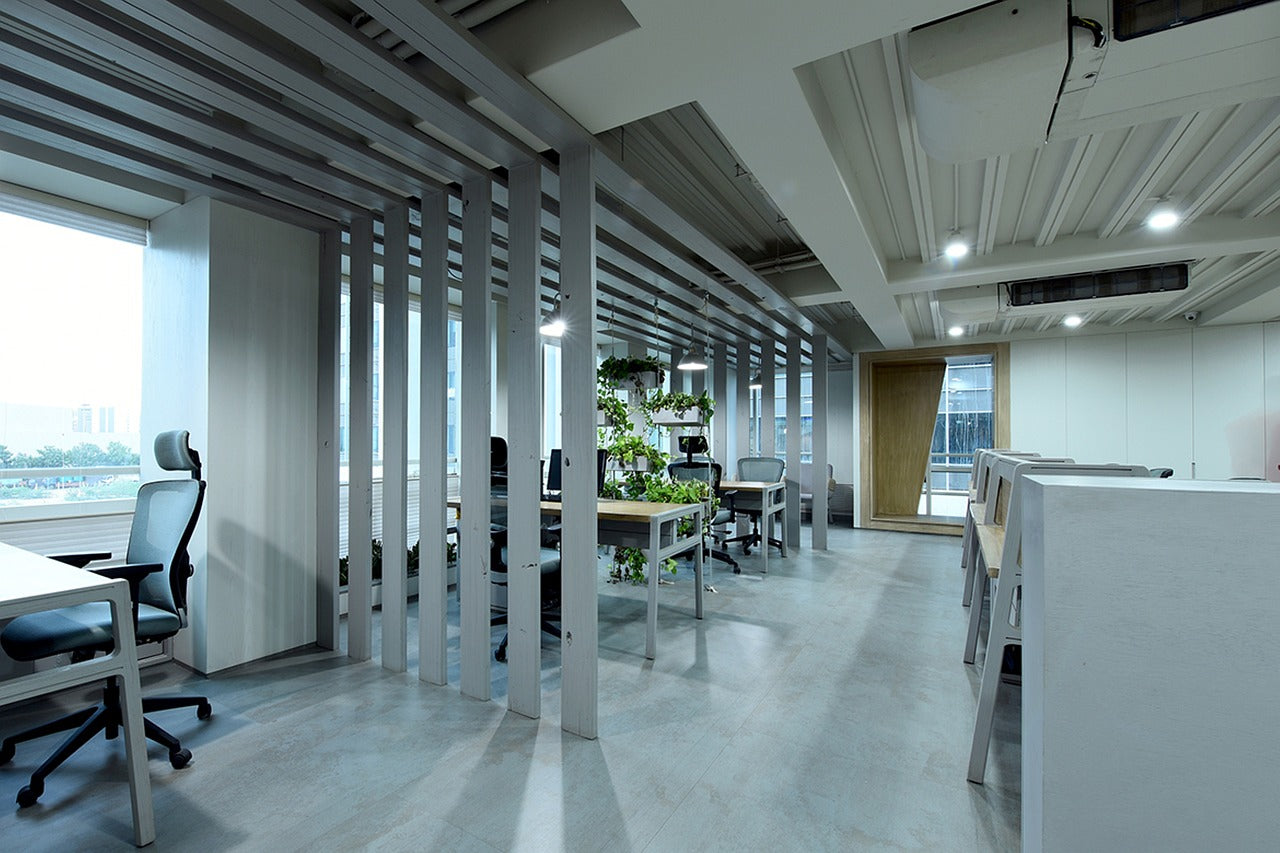
Ergonomics Examples in Offices: Problems and Solutions
Too often, business leaders and office planners forget about ergonomics, leading to back pain and discomfort for employees. By considering ergonomic hazards in your office design, you can ensure your employees stay comfortable and pain-free throughout the work day—resulting in more productivity.
Does your office design incorporate ergonomics?
Keep reading as we discuss everything you need to know about ergonomic hazards, resolving them, and what happens when you sustain an ergonomic injury. For ergonomic furniture options, why not check out the range of ergonomic design furniture at Freedman's Office Furniture?
Learn All About Ergonomics
Most people aren't aware of what ergonomics means or why it is essential in an office environment. In this section, we’ll explore the ins and outs of ergonomics and its importance.
What is Ergonomics?
Ergonomics refers to the study of what makes people productive and what makes a working environment suitable for efficiency, focus, and comfort. It is a term that encapsulates the physiological elements of productivity.
A workplace designed with ergonomics in mind will provide comfort for the specific tasks at hand to avoid repetitive stress injuries. Each furniture item, and the room's acoustics and temperature, play a role in ergonomic office design.
Why is Ergonomics Important?
You can incorporate ergonomics into your office design in many ways, and even upgrade your existing office space with ergonomic features. But why is ergonomics so important?
If your employees are uncomfortable while working, this will significantly impact their well-being, productivity levels, and job satisfaction. All of these things are essential to ensure your company thrives. By considering ergonomic hazards in your office design, you can boost your employees' productivity and quality of life, taking the human factors of business operations onboard.
The Principles of Ergonomics
Now that we have outlined ergonomics, let's go into some more detail. Below is a list of all factors and principles behind ergonomic design.
Safety
Ergonomics is about protecting individuals from injuries like repetitive stress injuries and carpal tunnel syndrome. With poor ergonomics, workers are more likely to experience stress and strain on the body or develop orthopedic disorders.
Comfort
Comfort is essential for employees and workers. Your work environment should provide enough comfort that you are not distracted from your tasks. This includes noise levels, posture, seating options, and temperature settings.
Aesthetics
A visibly cluttered, dingy, or dark work environment will hurt your mental health. This is why aesthetics should always be considered in ergonomic design. A workplace should be tidy and have enough light exposure to facilitate a positive mood and focus.
Productivity and Performance
If you feel uncomfortable, this can be distracting. You will not be as productive and your performance will suffer. If you can sit comfortably and work for long periods without strain, you will notice that you can maintain more consistent productivity throughout the day.
Ease of Use
Convenience and ease of use are essential considerations in ergonomic design. Physical obstacles can make tasks take longer and increase feelings of frustration. Creating ease of use and clear pathways for completing tasks is all part of ergonomics.
Ergonomics Issues
What happens when you have poor ergonomics? Let's discuss some consequences of not considering ergonomic hazards in your designs.
Blurred Vision
If workers cannot see their computer screen clearly or are exposed to flashing lights and visually detrimental stimulation, this could lead to blurred vision. It is essential to provide ample light and ensure your employees can always clearly see what they are working on, without strain.
Joint Stiffness
Remaining in the same position for hours on end can lead to joint stiffness, particularly if those joints are not supported with comfortable and ergonomic design features.
Decreased Range of Motion and Grip Strength
Sedentary positions can decrease someone’s range of motion over time—your employees shouldn’t sit in the same position for hours without stretching their legs. Grip strength, too, can suffer—primarily if you do not provide ergonomics for keyboards.
Pain
When one sits, or even stands, in an uncomfortable position for hours, this can lead to significant pain. Pain in the feet, buttocks, and back are all common when ergonomics are not considered.
Muscle Weakness
If you don't use it, you do indeed lose it. When employees aren't active enough, they lose strength in essential muscles. This can lead to musculoskeletal disorders.
Swelling and Inflammation
When your body is not supported, and your joints become sore, this can also lead to swelling and inflammation. This swelling and inflammation, in turn, leads to migraines, headaches, and other complications.
Tingling and Numbing
When you have an incorrect or unsupported posture, your body can remain in positions that cut off the circulation and blood flow to the hands, feet, and other areas. If you experience tingling and numbing sensations while working, it's time to look at the ergonomics of your workspace.
Ergonomics Hazards in the Office
When creating a more ergonomic office design, you need to know the ergonomic hazards to look for. Here are the top ergonomic risks you must eliminate or lessen with your office furniture and design.
Poor Sitting Posture
Poor sitting posture can lead to back pain, thoracic outlet syndrome, and other orthopedic issues. Specific muscles and areas can weaken or change structure if the spine is not properly supported.
Chair Too Low for Desk
If your chair is too low for your desk, you must look upwards at your computer screen. This means you will never be able to assume a resting neutral spine as you work, which leads to back problems.
Improperly Adjusted Workstations and Chairs
Similarly, if workstations and chairs are not adjustable, this can lead to hunching, leaning forward, and resting your hands uncomfortably to use a keyboard.
Repetitive Movements
The body's movements are meant to vary. Repetitive stress injuries occur when an individual does not change their movement pattern often. Similarly, if these movements are not supported, this can result in pain.
Frequent Lifting
Lifting places great strain on the body, especially if the person lifting has not been given proper instruction on how to lift properly. Choosing lightweight furniture and rollable office furniture will help to reduce strain due to lifting.
Upward Sloping Keyboard
An upward-sloping keyboard can cause hyperextension in your wrists and fingers, leading to joint pain as a day progresses.
Awkward Posture
Twisting to the side or viewing your workspace at an angle can lead to awkward positions that cause discomfort.

Frequently Using Too Much Force
If you must use force for your daily work routine, this can lead to stress in areas of the body. You are meant to spend the workday with intermittent rest periods, and too much force can go against physical ergonomics.
Poor Lighting
Eye strain can occur when there isn't sufficient lighting in your workplace. Computer screens provide light for visibility, but sitting in a darker environment for long periods is unhealthy for your vision.
Vibration
If there are heavy-duty tools in your workplace, you need to think about vibration. It can be mentally and physically distressing for the body to undergo extended periods of vibration.
Prolonged Stationary Position
Movement is the key to physical ergonomics, and prolonged periods of sitting or standing can lead to severe discomfort. There should be potential for frequent movement to ensure that employees do not suffer pain or strain at the end of the day.
Potential Ergonomic Injuries: 10 Examples
Let's explore some of the consequences of sustained poor ergonomics. Over time, if you don't review your office ergonomic hazards, your employees could experience the following issues with their physical health.
Back or Neck Pain
Back and neck pain can seriously inhibit your quality of life. Poor posture, a lack of lumbar support, and poorly positioned desk height will eventually lead to back or neck pain for your employees.
Tendonitis
If you injure your tendons, they may swell and become inflamed, resulting in tendonitis. This condition leads to pain, stiffness, and discomfort. If you do not invest in an ergonomic keyboard, your employees may suffer from tendonitis.
Digital Eye Strain
It is unhealthy for an employee to look at a computer screen for extended periods. Digital eye strain is an ergonomic hazard that occurs when employees are not exposed to sunlight throughout the day. If the computer screen is too close or too far away from their face, this will also lead to digital eye strain.
Trigger Finger
Trigger finger is a type of tendonitis in the finger that can make it difficult to curl your fingers. If you have a non-ergonomic computer mouse, this could lead to trigger finger.
DeQuervain’s Syndrome
DeQuervain's Syndrome affects the tendons in the thumb, making it difficult to move the thumb without discomfort or pain. It can be caused by extended periods of writing, using a keyboard, or using a computer mouse. This condition can sometimes be confused with carpal tunnel syndrome, which affects the wrists.
Ruptured Discs
Ruptured discs occur when the spine has sustained an injury. Sitting with poor posture can cause the discs in your spine to slide and rupture. This condition can cause severe physical impairment and affect a person's life.
Epicondylitis
Epicondylitis is a condition that causes inflammation around the elbow area. It can be caused by repetitive stress to the area or hyperextending the joint.
Arthritis
Many factors can cause arthritis, and sometimes it can be hereditary. However, repetitive motions or increased force with your hands, knees, or joints can also lead to inflammation and arthritis. Arthritis can make it hard to complete simple tasks, so organizational ergonomics is essential.
Thoracic Outlet Syndrome
Thoracic outlet syndrome (TOS) occurs when poor posture or cervical ribs cause compression in the thoracic (neck and spine) region. This compression can constrict blood flow, leading to numbness and poor circulation in the hands and feet. TOS can also cause back pain. To avoid TOS, having excellent posture and stretching the thoracic region regularly is important.
Ergonomic Equipment: 9 Examples
So, what can you do to remove ergonomic hazards in your workplace? Here are some of the foundational pieces of equipment for ergonomics.
Desk Risers
If your desks are not at the right height, you can invest in adjustable desk risers. You can use these to adjust the height of your desks by extending the legs, ensuring that your employees are not craning their necks to see their computer screens.
Ergonomic Mouses and Keyboards
To avoid carpal tunnel syndrome and arthritis, you can invest in ergonomic mouses and keyboards. With ergonomic design, they will provide enough support and comfort to prevent injuries and stress.
Standing Desks
Movement is at the heart of ergonomics, and by investing in standing desks, you can ensure that your employees only sit for a short period at a time. Opting for a sit-stand desk gives your employees the choice of standing or sitting throughout the workday, which will improve their posture.
Kneeling Chairs
Kneeling chairs are a unique ergonomic design. They reduce foot strain by allowing workers to use their knees for support. The chair has the occupant leaning forward, which promotes healthy spine positioning.
Ergonomic Office Chairs
Ergonomic office chairs have several adjustable features to help your employee find the most comfortable position. The adjustable lumbar support allows the employee to tailor the chair to suit their body shape.
Saddle Chairs
Saddle chairs are excellent for sciatica sufferers and can help to reduce discomfort in the lower back while also strengthening the back. They help to minimize hunching, poor posture, and all of the issues that result from poor posture.
Balance Balls
Balance balls are a great way to improve your spine health, core strength, and weight loss while working. Though they may be an unconventional seating option, they can seriously enhance your employees' health and your office's ergonomics.
Laptop Stands
Keeping laptops and monitors at eye level is essential for ergonomics. Investing in laptop stands with adjustable heights will help ensure that your desks are suitable for employees of all heights.
Keyboard Trays
Keyboard trays provide padding for the wrists and allow employees to adjust the height of their keyboards. Providing cushioning for the wrists will prevent strain that leads to arthritis, tendonitis, and other hand issues.
FAQ
Now you’ve read the article, let's discuss some lingering questions you might still have about ergonomics!
Which Repetitive Tasks Can Lead to Ergonomic Risks?
Hammering, using a mouse, and performing repetitive tasks that require a strong grip can lead to ergonomic risks. For these tasks, it's important to ensure there is cushioning for the equipment and to enforce regular breaks.
How Can I Adjust Chairs and Workstations Properly?
You'll need to invest in adjustable desks, chairs, and laptop stands to adjust chairs and workstations properly. This way, your employees can ensure they are not hunching at their desks. They can also ensure that their computer screens sit at eye level so they can avoid looking up or down to see their work clearly.
How Can I Encourage Proper Posture in the Workplace?
To encourage proper posture in the workplace, you can avoid chairs that do not support the back properly. You can also invest in standing desks or adjustable chairs, ensuring employees can keep their posture in any position.
What Kind of Strenuous Activities Lead to Ergonomic Injuries?
Lifting and pushing heavy objects can, over time, lead to ergonomic injuries and trapped nerves. Investing in moving equipment can help reduce the risk of these ergonomic hazards.
How Can I Prevent Ergonomic Injuries in the Work Environment?
To prevent ergonomic injuries in the workplace, you need to think about every aspect of ergonomics. You must consider cognitive ergonomics, such as eye strain and the noise level. You must also consider physical ergonomics, such as posture and the potential for injury. To prevent damage, consider all ergonomic hazards during the design process.
Conclusions
When designing your office space, it's essential to understand what ergonomics is and why it's so important. By keeping ergonomics in mind when creating your office space, you can avoid injuries and ergonomic hazards that could decrease your employees' job satisfaction and quality of life.
To browse for ergonomic furniture, why not check out our collections at Freedman's Office Furniture? We believe that ergonomics are essential to a safe and happy working environment!





